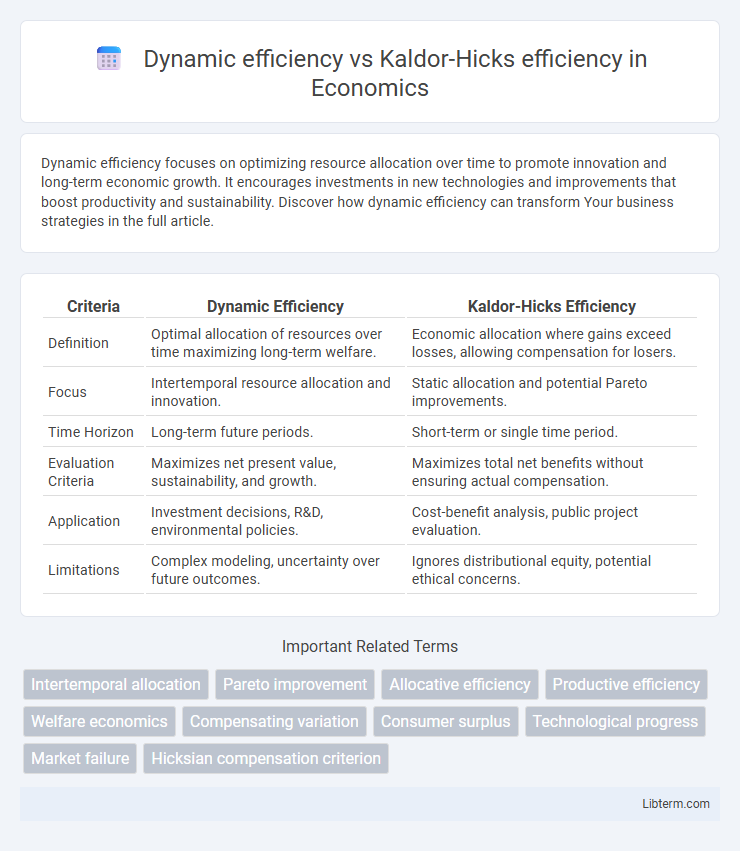Dynamic efficiency focuses on optimizing resource allocation over time to promote innovation and long-term economic growth. It encourages investments in new technologies and improvements that boost productivity and sustainability. Discover how dynamic efficiency can transform Your business strategies in the full article.
Table of Comparison
| Criteria | Dynamic Efficiency | Kaldor-Hicks Efficiency |
|---|---|---|
| Definition | Optimal allocation of resources over time maximizing long-term welfare. | Economic allocation where gains exceed losses, allowing compensation for losers. |
| Focus | Intertemporal resource allocation and innovation. | Static allocation and potential Pareto improvements. |
| Time Horizon | Long-term future periods. | Short-term or single time period. |
| Evaluation Criteria | Maximizes net present value, sustainability, and growth. | Maximizes total net benefits without ensuring actual compensation. |
| Application | Investment decisions, R&D, environmental policies. | Cost-benefit analysis, public project evaluation. |
| Limitations | Complex modeling, uncertainty over future outcomes. | Ignores distributional equity, potential ethical concerns. |
Introduction to Economic Efficiency
Dynamic efficiency measures the optimal allocation of resources over time, ensuring sustainable growth and innovation, while Kaldor-Hicks efficiency focuses on resource reallocation where winners gain more than losers lose, without requiring unanimous consent. Economic efficiency evaluates how well resources are used to maximize output and welfare, with dynamic efficiency emphasizing long-term benefits and Kaldor-Hicks efficiency highlighting potential Pareto improvements. Understanding these concepts is crucial in welfare economics and policy analysis for balancing immediate gains with sustainable progress.
Defining Dynamic Efficiency
Dynamic efficiency evaluates resource allocation over time, ensuring sustainable growth and innovation by balancing present consumption with future benefits. Unlike static Kaldor-Hicks efficiency, which measures immediate welfare gains and losses, dynamic efficiency emphasizes long-term productivity gains and intertemporal trade-offs. It plays a critical role in policy decisions involving investments, environmental sustainability, and technological progress.
Explaining Kaldor-Hicks Efficiency
Kaldor-Hicks efficiency measures an economic outcome where the gains of winners exceed the losses of losers, allowing potential compensation to create a Pareto improvement, even if actual compensation does not occur. Unlike dynamic efficiency, which emphasizes optimal resource allocation over time for sustained growth, Kaldor-Hicks efficiency focuses on static resource reallocation to enhance overall welfare at a given moment. This concept is widely used in cost-benefit analysis to justify policies or projects that increase net social welfare despite creating some losers.
Key Differences Between Dynamic and Kaldor-Hicks Efficiency
Dynamic efficiency emphasizes resource allocation over time to maximize long-term growth and innovation, prioritizing investment and technological progress. In contrast, Kaldor-Hicks efficiency evaluates economic outcomes by potential compensation, focusing on gains exceeding losses in a static context without requiring actual compensation. The key difference lies in dynamic efficiency's focus on temporal optimization and sustainability, whereas Kaldor-Hicks efficiency centers on Pareto improvements based on net benefits at a given point in time.
Importance of Innovation in Dynamic Efficiency
Dynamic efficiency emphasizes long-term growth by fostering innovation, which drives technological progress and resource reallocation over time. Kaldor-Hicks efficiency measures resource allocation improvements based on potential compensation without requiring actual compensation, focusing more on static efficiency. Innovation is crucial in dynamic efficiency as it enables continuous improvements and productivity gains, ensuring sustainable economic development beyond immediate resource use.
Welfare Implications of Kaldor-Hicks Efficiency
Kaldor-Hicks efficiency evaluates welfare improvements by comparing potential compensation between winners and losers, allowing reallocations that increase total social welfare even if some individuals are worse off. This concept prioritizes aggregate welfare gains without requiring actual compensation, contrasting with Pareto efficiency's stricter criteria. However, its application may lead to policies that enhance overall efficiency at the expense of equity and distributional fairness.
Real-world Examples of Dynamic Efficiency
Dynamic efficiency emphasizes long-term innovation and sustained growth, evident in technology firms like Tesla investing heavily in electric vehicle R&D to outpace competitors. Kaldor-Hicks efficiency focuses on potential compensations where gains exceed losses, often applied in public infrastructure projects like highway expansions enabling broader economic benefits. Real-world examples of dynamic efficiency showcase companies prioritizing continuous improvement and adaptation, which drive productivity and market dominance over time.
Applications of Kaldor-Hicks Efficiency in Policy
Kaldor-Hicks efficiency is widely applied in policy decision-making where resource allocation aims to maximize overall social welfare, even if some individuals are made worse off. It assists governments in evaluating projects like infrastructure development by weighing total benefits against costs, ensuring net positive outcomes without requiring unanimous consent. Unlike dynamic efficiency, which emphasizes intertemporal resource allocation, Kaldor-Hicks focuses on static improvements within a specific policy timeframe, facilitating practical compensation mechanisms for affected parties.
Limitations and Criticisms of Both Concepts
Dynamic efficiency often faces criticism for its reliance on long-term projections, which can be uncertain and speculative, making policy application challenging. Kaldor-Hicks efficiency is limited by its assumption that winners can theoretically compensate losers, ignoring practical issues of distributional equity and often neglecting the social or environmental impacts that are not easily quantified. Both concepts struggle with real-world applicability due to their theoretical foundations that may overlook temporal complexities and ethical considerations in economic decision-making.
Conclusion: Choosing the Right Efficiency Metric
Dynamic efficiency emphasizes long-term resource allocation and innovation, making it crucial for sustainable growth and technological advancement. Kaldor-Hicks efficiency prioritizes immediate gains, ensuring that overall welfare improves even if some parties lose out, which suits policy decisions focused on short-term redistribution. Selecting the appropriate metric depends on whether the objective is fostering future economic development or achieving present-day welfare improvements.
Dynamic efficiency Infographic

 libterm.com
libterm.com